United Kingdom
1982
"Death Centenary of Charles Darwin"
| Issue Date |
10.02.1982 |
| ID |
Michel: 906-909
Scott: 965-968 Stanley Gibbons:
1175-1178 Yvert: 102-1026 UPU: N/A
Category: Dw |
| Author |
designed by David Gentleman; The first day
cover was designed by Sutherland Hawes & Associates. |
| Stamps in set |
4 |
| Value |
15p Charles Darwin and Giant Tortoises
19p Charles Darwin and Marine Iguanas
26p Charles Darwin and Cactus Ground Finch and Large Ground Finch
29p Charles Darwin and Prehistoric Skulls |
| Size (width x height) |
41x30 mm |
| Layout |
100 stamps per sheet |
| Products |
FDC x 1 PP x1 |
| Paper |
unwatermarked phosphor coated paper |
| Perforation |
15x14 |
| Print Technique |
Photogravure |
| Printed by |
Harrison & Sons (High Wycombe)
Limited |
| Quantity |
|
| Issuing Authority |
Royal Mail of Great Britain |
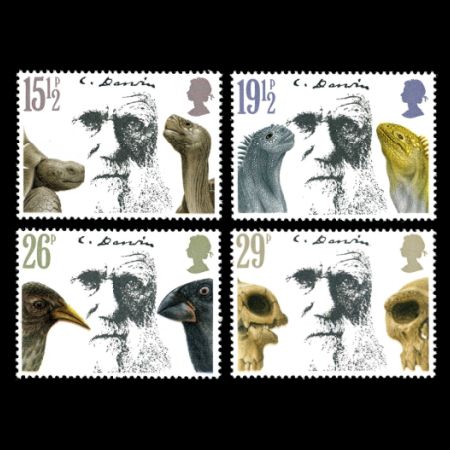 Charles Darwin
Charles Darwin
was born in 1809 and died in 1882. In his long life he
produced several books and wrote thousands of letters commenting on
many aspects of biology and geology. Although Darwin was an eager and
active explorer in his youth, riding, climbing, walking and collecting
his way round the world at the invitation of Captain Robert Fitz Roy of
the survey ship H. M. S. Beagle (1831-1836)-another aspect of him is
portrayed at the end of his long and often stormy career.
It is that of the venerable and bearded scientist whose once
revolutionary ideas had been accepted finally by his contemporaries.
Darwin kept notes and observations on the natural history and geology
of the countries he visited and on his return he immediately started
notebooks on the "transmutation of species".
He recorded that he had
been deeply impressed by three things during the Beagles voyage; the
similarities between fossil remains and recent animals in South
America, the geographical distribution of animals in that continent,
and the productions of the Galapagos Islands more especially by the
manner in which they differ on each island of the group' The Galapagos
Islands are a group of volcanic islands in the Pacifc Ocean on the
equator and 600 miles west of Ecuador. The land animals and plants
which were able to colonize the islands have developed in isolation
into new species, not only different from the nearby continent, but
showing differences between the various islands.
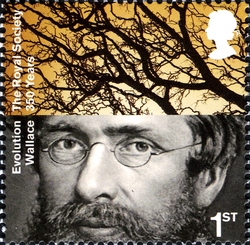
Darwin devoted years of study to collecting information about the
problem of species, and in thinking about explanations and mechanisms
for the transmutation of species which he felt sure had taken place,
and was taking place. While gathering material for his giant book
Natural Selection; a letter from
Alfred
Wallace who had similar ideas,
precipitated him into producingan abstract of his ideas published in
1859 and now known as the Origin of Species!' That book with its
detailed evidence and strongly argued case for gradual change and
adaptation in animals and plants had a profound effect not only on
biology but also in many other areas of thought and activity where
change and adaptation became issues.
Darwin, as Britain's greatest biologist, should be remembered not only
for his Theory of Evolution (a word he rarely used) but also for the
outstanding contribution he made to geology, soil science, the study of
animal behaviour, and experimental botany.
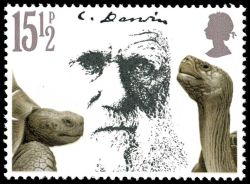 Giant
Tortoises
Giant
Tortoises
The word Galapagos means tortoise, and the giant tortoises of the
various islands have become adapted to feed in different ways to
exploit the available food. The dome shaped' tortoises are ground
feeders eating cactus pads and low growing plants, the 'saddle backed
tortoises with their long necks and flared carapace stretch up and feed
on bushes and taller cacti. The tortoises from the different islands
were an important source of food to passing ships as they could be kept
alive for a long time aboard ship and provided much-needed fresh meat.
Many thousands were killed and since Darwin's visit some of the species
have become extinct and others have only survived because of determined
efforts to protect and breed these magnificent reptiles. |
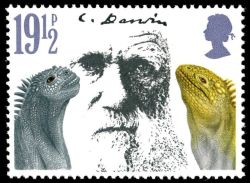 Marine Iguanas Marine Iguanas
There are two types of iguana on the Galapagos which also have island
differences. The dark marine iguana, 'imps of darkness feed on seaweed
in the cold waters round the rocky coasts. They spend a considerable
part of their day basking in the sunshine after their feeding
excursions in the sea. Their broad, blunt jaws and armoured heads
protect them from the sharp rocks even in rough water. The land iguana
which feeds on cactus pads and other plants, has a tail with around
section and anarrower face with less protection. During Darwin's visit
it was so abundant that it was diflicult to find ground free from its
burrows for pitching a tent. The introduction by settlers and sailors
of goats, pigs and dogs resulted in the trampling of nesting burrows,
competition for food and predation of the young, and the land iguana is
now a mumch less common aniamal. Conservation measure to remove the
feral animals are allowing it to recover and recolonize areas where it
had become extinct. |
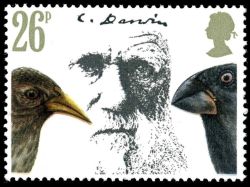 Cactus Ground Finch
and Large Ground Finch
Cactus Ground Finch
and Large Ground Finch
The main small land birds on the Galapagos are a complex, inter-related
group of species now called Darwin's Finchesl' These small sparrow-like
birds have a bewildering variety of beak shapes and sizes, and a
confusing similarity of plumage. The explanation for this variety may
be that the Galapagos Islands were originally colonized by a finch
species from nearby South America. As with the tortoises and the
iguanas, island races or species eveloped in the isolated populations.
In the finches things seem to have gone a stage further as the various
island finches seem to have reinvaded each other's islands leading to
competition and further modification to different feeding methods to
allow co-existence |
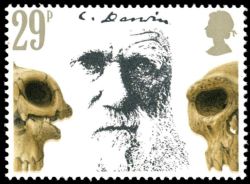 Prehistoric Skulls Prehistoric Skulls
At left Australopithecus robustus, at right Homo erectus |
Products
| Official
and some personalized FDC |
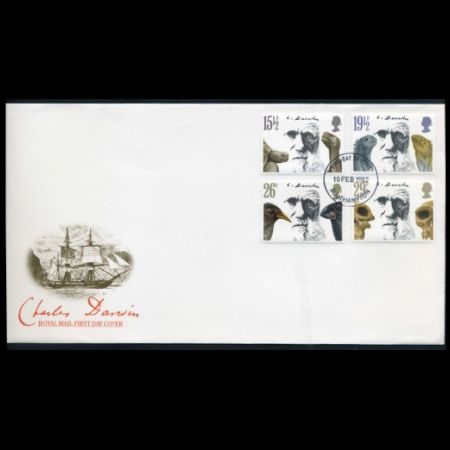 |
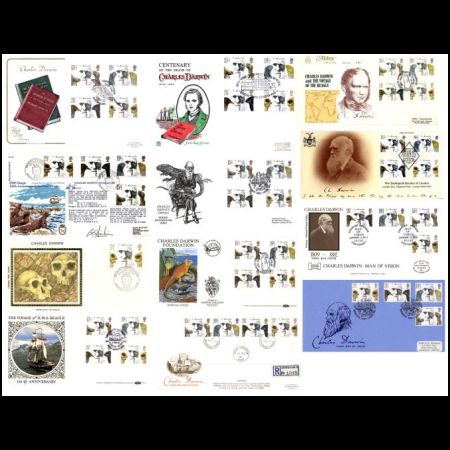 |
| Presentation
Pack |
Post
Cards |
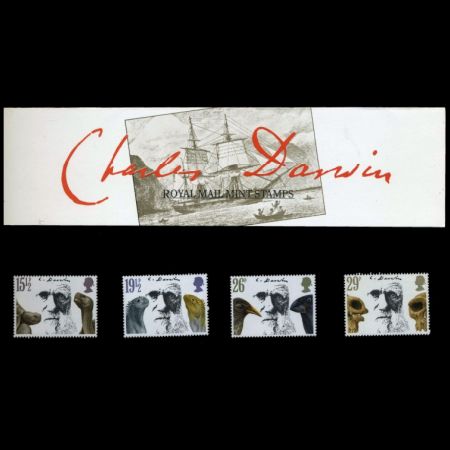 |
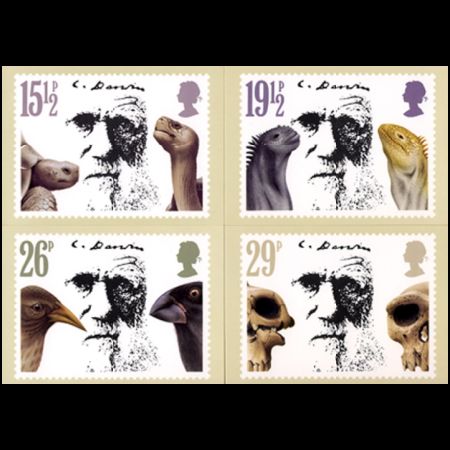 |
| Used cover |
|
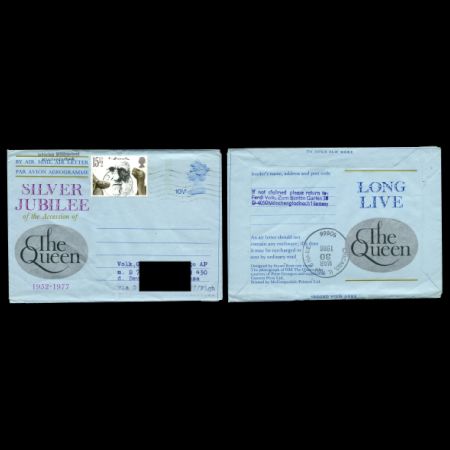 |
|
References:
Wikipedia
BFDC
Inside pages of
FDC
and
Presentation
Pack
Latest
update 18.12.2017
Any feedback, comments or even
complaints
are welcome: admin@paleophilatelie.eu (you
can email me on ENglish, DEutsch, or RUssian)

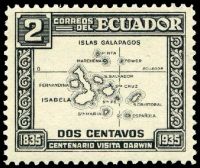 Ecuador 1935, map of Galapagos insels. Part of the
first stamp set depicting C. Darwin
Ecuador 1935, map of Galapagos insels. Part of the
first stamp set depicting C. Darwin Darwin devoted years of study to collecting information about the
problem of species, and in thinking about explanations and mechanisms
for the transmutation of species which he felt sure had taken place,
and was taking place. While gathering material for his giant book
Natural Selection; a letter from Alfred
Wallace who had similar ideas,
precipitated him into producingan abstract of his ideas published in
1859 and now known as the Origin of Species!' That book with its
detailed evidence and strongly argued case for gradual change and
adaptation in animals and plants had a profound effect not only on
biology but also in many other areas of thought and activity where
change and adaptation became issues.
Darwin devoted years of study to collecting information about the
problem of species, and in thinking about explanations and mechanisms
for the transmutation of species which he felt sure had taken place,
and was taking place. While gathering material for his giant book
Natural Selection; a letter from Alfred
Wallace who had similar ideas,
precipitated him into producingan abstract of his ideas published in
1859 and now known as the Origin of Species!' That book with its
detailed evidence and strongly argued case for gradual change and
adaptation in animals and plants had a profound effect not only on
biology but also in many other areas of thought and activity where
change and adaptation became issues. 








